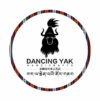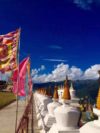Geography
Located near the border of Daofu County, Danba County, and Kangding County, of Ganzi Autonomous Prefecture, Yala Mountain (བཞག་བྲ།)is one of the most popular mountain treks in the Sichuan region. With snow covered peaks year round, Mt. Yala has an elevation of 5,820 meters and offers several trek options for mountain enthusiasts. The area around the border of Kangding that includes the mountain range is also a nature preserve.
History
Aside from being a large attraction for visitors to the area, it is also one of four holy mountains worshiped by the local Tibetans. It is mentioned in the Epic of King Gesar in this way and held highly by the locals in this regard. In ancient Tibetan texts, the mountain is referred to as “Shambhala the Second” and also “Oriental White Yak” and contains many religious and prayer flags hung all around the mountain. Its name in Chinese is Yala Xueshan. Tibetans have been coming to Mt. Yala for centuries to hang their prayer flags in honor of the mountain spirits.

Scenery
Surrounding Yala Mountain to the north and northwest are the Tagong (Lhagong) Grasslands, creating a stunning contrast between the snowy mountain side and the grasslands below. Nearby villages can also be reached, including Danba, one of the most beautiful valleys in the region. It is popular to begin a few days trek to the mountain starting at Kangding or an even closer point around Zhonglu village, to have the best experience.

Trekking around or across Mt. Yala can take days and properly preparing should be a priority. Zhonggu sits at an altitude of around 3,000 meters and is a great location to ascend Mt. Yale’s eastern pass, which roughly sits around 4,216 meters. The trek is not steep and can be climbed with not too much difficulty. This can also make the change in elevation easier for those not used to such high altitudes. As Sichuan’s second highest mountain range, on a clear day you can see for miles, making this scenic trek very worthwhile indeed. Off in the distance, you may even be able to spot the peaks of Minya Konka, covered in snow.

Planning a Trip to Mt. Yala
If you plan on making the long trek and camping out in the area, there are a few things you should prepare for. The temperatures can drop well below 0 degrees at night, so a good four season tent is recommended, as well as sleeping bags that can handle these sub-zero temperatures. Plenty of layers of clothing to adapt to the changing temperatures throughout the day is also critical. Talk to Zhilam Hostel in Kangding if you’re looking to hire a local guide on location in Kangding, or contact Extravagant Yak for a quote on an all inclusive package tour from Chengdu.















































